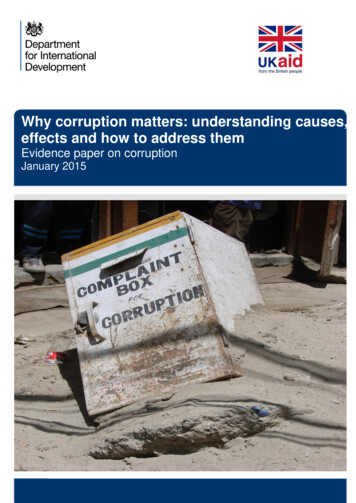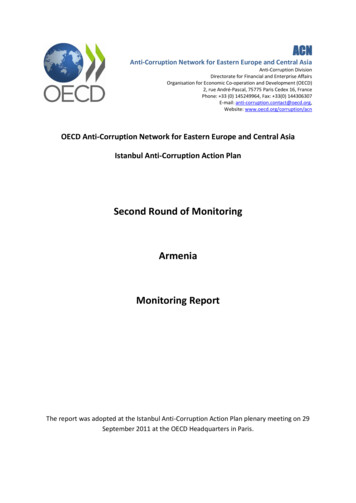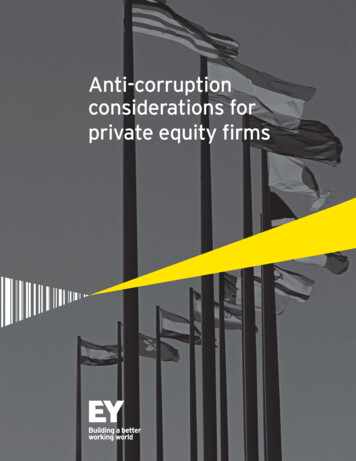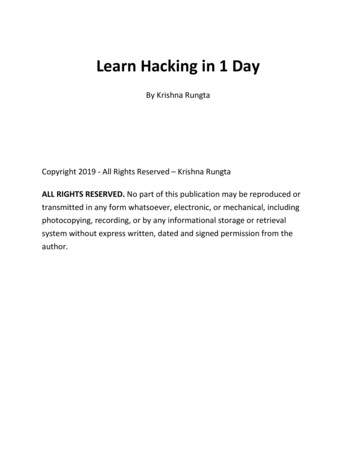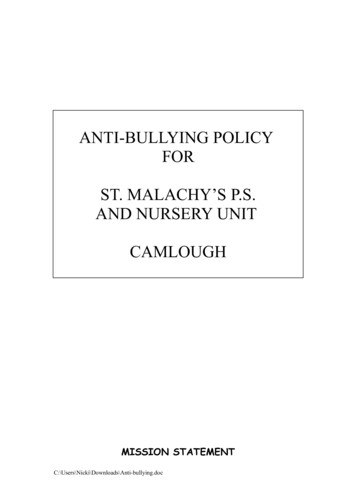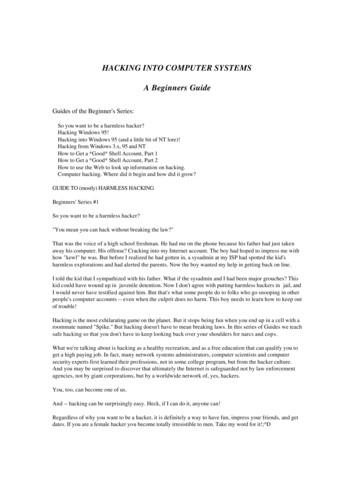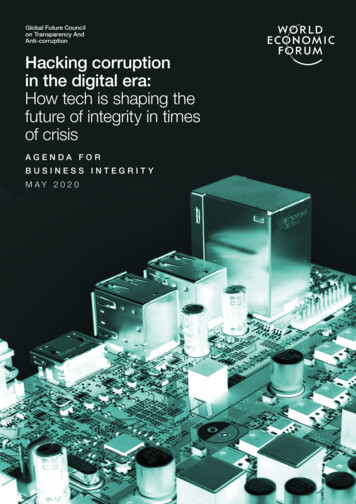
Transcription
Global Future Councilon Transparency AndAnti-corruptionHacking corruptionin the digital era:How tech is shaping thefuture of integrity in timesof crisisAGENDA FORBUSINESS INTEGRITYM AY 2 0 2 0Hacking corruption in the digital era1
Cover Photo Credit: Michael DziedzicAuthor: Carlos Santiso, Director for Digital Innovation inGovernment at the Development Bank of Latin Americaand member of the World Economic Forum’s GlobalFuture Council on Transparency and Anti-Corruption1This paper has been written by the World EconomicForum’s Global Future Council on Transparency andAnti-Corruption 2019-2020. The findings, interpretationsand conclusions expressed herein are a result of acollaborative process facilitated and endorsed by theWorld Economic Forum, but whose results do notnecessarily represent the views of the World EconomicForum, nor the entirety of its Members, Partners or otherstakeholders, nor the individual Global Future Councilmembers listed as contributors, or their organizations.This paper is part of the Agenda for Business Integrityand focuses on the pillar 3: leverage technologies toreduce the scope of corruption.Contents23Tech for integrity in times of crisis5How tech is shaping the future of integrity13Tentative conclusions in uncertain times14Global Future Council on Transparency and AntiCorruption 2019-202015EndnotesHacking corruption in the digital era
1Tech for integrityin times of crisis1.1 Tech is the most promising driver of integrity.Data-driven, tech-based anti-corruption solutionsare rapidly expanding in sophistication and potential.The transparency they enable is critical for anchoringconfidence in business and restoring trust ingovernment. Tech innovations, powered by data andbehavioural insight, are disrupting corruption risksand boosting integrity systems. They are acceleratingnew forms of accountability based on the smarterexploitation of big data and fostering new publicprivate partnerships for integrity. In the digital era,data has become a critical asset for integrity actors todetect and deter fraud risks, complex networks andcorrupt practices.1.2 Integrity analytics powered by ever-expandingdata are a corruption game-changer.With the Panamá and Paradise papers, advancedanalytics and artificial intelligence (AI) are becomingcritical anti-corruption levers. The insight they generatecan be used to better detect, reveal and detercorruption. They can raise red flags and early warningsin high-risk transactions and suspicious financial flowsin seconds by cross-referencing public databasesFIGURE 1and big data. At the same time, predictive analyticscan pinpoint vulnerabilities and pre-empt risks. Whencombined with insight from behavioural science (WorldBank 2018),2 they help devise more targeted buffersagainst fraud. According to Gartner, data analytics isreaching its “slope of enlightenment”.Hype Cycle for Digital Government Technology, 2019Source: Gartner (2019)Hacking corruption in the digital era3
1.3 The COVID-19 pandemic increasescorruption risks.Corruption thrives in times of tragedy. Pandemicoutbreaks and natural disasters are fertile ground forfraud. To fight the COVID-19 pandemic, governmentsneed to act urgently to save lives in the midst ofthe worst pandemic in a century. In the short term,containment of the pandemic and management ofthe health crisis require emergency powers to procuremedical supplies swiftly to save lives, suspendingstandard procurement rules. In the medium term,the emergency programmes and recovery packagesgovernments are developing with the backing of theInternational Monetary Fund (IMF) and multilateraldevelopment banks to respond to the economic andsocial consequences of the health crisis will involvedeploying vast amounts of resources in a very shorttime to protect the vulnerable, shield small businessesand revive the economy.1.4 In emergencies, transparency saves lives.Health emergencies and natural disasters areparticularly vulnerable to corruption and governments’emergency responses often incubate opportunitiesfor fraud. These risks need to be recognized andaddressed. There are two main risks factors: thoserelated to the immediate response to the healthcrisis (emergency response) and those related togovernments’ response to its economic consequences(recovery response), deactivating much-neededsafeguards and checks and balances.3 Emergencyprocurement is particularly exposed.1.5 To confront the COVID-19 pandemic, technologyis the best prescription against corruption.Tech-powered and data-based anti-corruptionsolutions are critical to strengthening the safeguardsnecessary to mitigate the corruption risks inherent toemergency response. Open data is not only especiallyimportant in the procurement of emergency medicalsupplies during the outbreak, but also as part ofgovernments’ economic response and stimulusprogrammes to counter the economic impact andsocial consequences of the crisis.41.6 Tech trends are shaping the future of integrityin three important ways:By a) strengthening integrity and compliancesystems within business, b) transforming the integrityenvironment in which businesses operate; and c)changing global incentives for integrity in business.This paper explores how businesses can work with4Hacking corruption in the digital eragovernments to leverage new technologies and dataintelligence to curb corruption and strengthen integrity,especially in confronting the COVID-19 pandemic.Public-private partnerships for integrity are needed torecover from the crisis.
2How tech is shapingthe future of integrity2.1 Tech for integrity: Opportunities for businessUnlocking thenext generation oftech for integrityinnovations withinbusiness entailsa combination ofactions, focusingin particular onleveraging thepower of datacompliance programmes. Insight from riskassessments and investigations helps developtargeted training, tailored guidance and moresuccessful audits, as well as better internal andexternal reporting. The cooperation betweencompliance officers, industry regulators andtech start-ups is particularly promising. Regtechsolutions developed by tech start-ups haveexpanded beyond the financial sector and areincreasingly being deployed for risk profiling anddue diligence.Tech-based, data-intensive innovations enhancethe effectiveness of business’ compliancesystems. Global business has made considerableprogress in strengthening its internal integrity systemsto fend off fraud, developing ethics standards andcompliance programmes to prevent bribery. Whilecompliance is, by its nature, reactive to potentialrisks, the more proactive concept of collective actionis gaining ground, through industry-wide standards,common positions and public-private partnerships.Business commitment to integrity is critical duringand after a crisis, as temptations for fraud andbribery are particularly intense to increase profitmargins, defend market shares and gain competitiveedge. The reputation costs of integrity breacheswill be dire, however. As Alison Taylor underscores:“How companies conduct themselves within andwithout (during the crisis) will help determine theirfuture societal value. The public will assess whetherenterprises deserve to survive.”5Unlocking the next generation of tech for integrityinnovations within business entails a combination ofactions leveraging the power of data.–Strengthen the autonomy of complianceoffices and their capacity for integrityanalytics. This entails developingcorporate ethics standards, consolidatingwhistleblowing programmes, strengtheningsanctions regimes and expanding the reach ofcompliance systems to the entire supply chainto local, small and medium-sized enterprises.It also requires promoting integrity policiesfor small enterprises, using mentoring fromlarger firms within their supply chain, collectiveaction, and other similar strategies. Digitalizingcomplaints systems will allow mining theinformation, identifying risks along the supplychain and addressing critical pain points.–Invest in tech innovations and data analyticsto mitigate risks, improve due diligenceand ensure regulatory compliance. Dataintelligence significantly enhances risk-based–Adopt sound corporate governancepractices, informed by evidence and data.Fostering cooperation with the public sector inthe preparation of guidelines and regulationson corporate governance is important. Thoseshould be based on the deeper insightgenerated by data mining regulations andusing data analytics in the preparation of newlegislation.–Scale-up investments in data infrastructureand strengthen analytics capabilities togenerate high-quality assets for businessintelligence. Too much data gets collected;not enough gets used. Business shouldstrengthen its capacities to mine its own datato detect fraud risks, while preserving personalprivacy, in line with relevant data protectionlegislation. The quality of underlying dataused by compliance officers is critical, pairedwith structural data governance protocols toguarantee the quality, integrity and securityof the data upon which they rely. In addition,industry-wide and sector-specific codes ofconduct on the ethical and responsible use ofAI are needed. Many companies are creatingchief data and analytics officers to govern theirdata, which ought to further their cooperationwith compliance officers to leverage insightfrom integrity analytics and better assess risks.–Open corporate data. Business should committo open up non-sensitive corporate governancedata critical for integrity, such as beneficialHacking corruption in the digital era5
ownership, board membership, interest andasset declarations, lobbying meeting records,and tax records. They should also adopt policieson the disclosure of the financial dealings withpublic officials and politicians. Tech start-upscan help. For example, Open Corporates makespublicly available company data accessiblein a structured manner, including beneficialownership, one of the biggest challenges todealing with tax evasion and money laundering.6The COVID-19crisis has exposedthe shortcomingsof analoguegovernmentsrelying on paperand physicalprocesses andis acceleratingthe need forgovernment togo digital––Disclose private-sector data deemed tobe of public interest. Encourage industrywide business-to-government data-sharing,as part of business commitment to corporatesocial responsibility. Business should work withgovernments to develop standards, regulationsand protocols to share non-commercial, nonsensitive private-sector data that is deemedof public interest and whose reuse helpsimprove public policies (including health safety)and government decision-making. In France,the 2016 Digital Republic Bill introduced theconcept of “public interest data”.7 In Europe,data sharing between businesses andgovernments is central to Europe’s new digitaland data strategy unveiled in February 2020,including on AI. In this regard, global businessought to consider the recommendations of thereport of the EU High-Level Expert Group onBusiness-to-Government Data Sharing.Invest in smarter regulation, leveraging newtechnologies and data insight. Advancedanalytics help develop better regulations andfacilitate regulatory compliance. Businessshould engage with regulators to improve rulemaking, risk management and compliancecontrol using crowdsourcing and regtechsolutions. Digital databases, data mining andmachine learning can improve the making ofnew regulations and avoid regulatory duplicationand conflicting guidelines. Machine learningand natural-language processing techniquesmake it possible to process large amounts ofinformation, such as public inputs to regulatoryproposals. Advanced analytics and AI enablegovernments to improve the design, deliveryand enforcement of regulations, reduceregulatory burden and enhance regulatoryimpact analysis.Regulators can use advanced analytics topredict where they should apply their regulatoryefforts, including investigations and inspections,or use machine learning tools to predictthe likely outcome of litigation. These techsolutions can also enhance regulators’ oversightcapacities by streamlining their operations6Hacking corruption in the digital eraand deploying their resources more effectively.Solutions provided by regtech and suptechstart-ups can help improve regulatory policy. Forexample, Mexico’s National Banking and StockCommission has partnered with the Regtechfor Regulators Accelerator to improve its antimoney-laundering safeguards.–Integrate a country’s level of digital maturityin risk assessments. Digital maturity reducescorruption vulnerability. Global business andinstitutional investors should consider the levelof digital maturity of governments in their riskassessments. The COVID-19 crisis has exposedthe shortcomings of analogue governmentsrelying on paper and physical processes andis accelerating the need for governmentsto go digital. The digital transformation ofbureaucracies offers tremendous opportunitiesto transition towards more agile governanceand smarter regulation.8 The digitalizationand simplification of bureaucratic proceduresincreases efficiency, reduces costs andstreamlines services to business and citizensalike. Digital public services reduce solicitationrisks and opportunities for bribery.–Move towards cashless economies anddigital transactions. Digital currencies cancurb one of the main vehicle for fraud: cash.Digitalizing payments increases transparencyin transactions and makes it more difficultto conduct criminal activities and moneylaundering. Central bank-issued digitalcurrencies mitigate some of the challenges thatelectronic payments have encountered.9 TheBetter than Cash Alliance is a partnership ofgovernments and companies that acceleratesthe transition from cash to digital in a way thatimproves lives and expands responsible digitalfinancial services.–Adopt digital identities and signaturesto prevent forgery. Government-certifieddigital identities and signatures are a criticalfoundation to the digital transformation of oureconomies. The new economy requires digitallyenabled authentication systems that certifythe identity of digital users. In any financialtransaction, knowing your customer is essentialto ensure that the funds involved are not linkedwith crime. Digitally signed documents areharder to forge and reduce solicitation risksby eliminating interactions with public officials.The FATF has recently issued guidance todetermine whether a digital ID is appropriatefor use for due diligence.10 Yet, governmentvalidated digital identification systems havebeen hard to implement.
2.2 Tech for integrity: Opportunities for governmentsare making governments more agile, efficientand predictable. As such, they improve thebusiness climate by reducing the administrativeburden and regulatory costs on business;they also increase transparency, predictabilityand traceability of bureaucratic processes.E-government reforms have enabledimprovements in critical dimension of thebusiness climate, as measured by the WorldBank’s Doing Business metrics – starting abusiness, registering property, getting electricity,getting credit, paying taxes, trading acrossborders, protecting minority investors, enforcingcontracts and resolving insolvency.11 In Africa,Rwanda is an example of the implementationof e-government reforms to enable economicgrowth.The digital transformation of governmentreduces opportunities for corruption, bothgrand and petty. The digitalization of the publicsector is a driver of change in the integrity space.By eliminating paper and opening up data, it cutsred tape and reduces solicitation risks through theautomation of public services, such as businesspermits and tax payments. The revelation ofusers’ experience with bureaucratic proceduresalso helps identify vulnerabilities and address painpoints, providing an opportunity to service usersto be part of the solution. Disruptive technologiessuch as blockchain are posited to securetransactions and tamper-proof records, makingthem corruption resilient with an unalterable audittrail. Similarly, digital identity solutions facilitate duediligence to manage compliance risk and preventmoney laundering.Tech solutionsare critical tocorruption-proofthe response tothe public healthcrisis, as well asthe crisis andrecovery packagesthat governmentsare designingto mitigateits economicand socialconsequences–Automate high-risk bureaucratic proceduresand public services, reducing discretionand solicitation risks. The complexity ofgovernment transactions adds to corruptionrisks. For example, in 2017, according toTransparency International, one in three LatinAmericans reported paying a bribe to accessa service – acquiring an identity document,registering in school, accessing a hospital,dealing with police and the courts, or accessingan utility. The “regulatory addiction” of manyLatin American countries increases the costsof doing business.12 Yet, less than 30% ofgovernment transactions can be completedonline from end to end and 25% of them requirethree or more visits to a public office.13–Digital services help cut red tape through theautomation of processes and the digitalizationof services.14 Online transactions increase bothintegrity and agility in regulatory processes.Digitalization and simplification mitigate briberyrisks by reducing interactions with publicofficials, increasing the availability of information,and eliminating opportunities for arbitrarydiscretion. Digitalization is particularly effectiveat preventing “petty corruption” in transactionssuch as paying for utilities, submitting incometax, registering new businesses, paying finesand fees, applying for birth and marriagecertificates, registering motor vehicles, andapplying for drivers’ licences and personalidentity cards.15–Focus digitalization efforts on high-risktransactions. These include in particular taxadministration, public procurement and financialmanagement, as well as company licensingand property registration. These public servicesrepresent critical pain points in public-privateinteractions. Business should work withgovernments to accelerate the digitalizationof tax administration (e-filing of taxes), customadministration (trade facilitation), licensingThe COVID-19 crisis is accelerating the digitaltransformation of governments and the urgencyto implement fully digital public services. Thepandemic is a “stress test” on a global scalethat gauges the degree of digital resilience ofour economies, societies and governments.Tech solutions are critical to corruption-proof theresponse to the public health crisis, as well as thecrisis and recovery packages that governmentsare designing to mitigate its economic and socialconsequences. Tech-based and data-driventransparency is more urgent than ever to safeguardintegrity in times of crisis.To rebuild better, governments can pursue gamechanging transformations by tackling pendingstructural challenges, including the following:––Accelerate the digital transformation ofpublic services. Governments around theworld are adopting ambitious strategies totransform public services through automation,simplification, and digitalization. Thesophistication of e-services varies, however,some providing information only and otherswith fully transactional information. Thecoverage of public services and the full end-toend digitalization of those services also vary.Singapore and Uruguay provide e-servicesthrough seamless m-government applicationsthat are paired with a single sign-on. By limitingface-to-face interactions with public officials,digital public services reduce solicitation risksand petty corruption in daily transactions.The success of e-government improvementsultimately rests on governments adopting thesetechnologies and businesses embracingtheir use.Expand digital government solutions tounlock productivity and competitiveness.The automation of bureaucratic proceduresand the digitalization of government servicesHacking corruption in the digital era7
(e-licensing), public contacting (e-procurement,e-tendering). For example, according to theWorld Bank report on digital dividends,16 e-fillingof tax obligations reduced tax compliance costs.Data usedfor integrityinitiatives must beunquestionable interms of qualityand reliability–Make the paying of taxes easier andcorruption-proof. Paying taxes is one of themain challenges to competitiveness, a criticalhindrance of business formalization, and acritical pain point in the corruption chain, asshowed by World Bank reports on payingtaxes.17 Digital solutions increase the efficiencyof tax collection and reduce tax fraud. Taxagencies have been at the forefront of the digitaltransformation, making voluntary complianceeasier for taxpayers and businesses alikethrough the digitalization of tax processes, prefilled tax returns and online payment systems.While having lagged, custom agencies suchas Singapore’s are gradually going digital tofacilitate trans-border trade.18Tax agencies are becoming increasingly savvyat leveraging data analytics and AI to detect anddeter tax fraud. They are targeting in particularhigh-risk areas such as the construction sector,real estate and the art industry. Data mining andfraud analytics solutions, using big data andsocial networking technologies, are boostingtax authorities’ oversight capabilities. In theUS, UK, France and Spain, tax administrationsuse AI to detect tax evasion. In France, the2020 budget law provides for increased use ofadvanced analytics to deter tax fraud and guidetax inspections. Privacy concerns need to beproperly managed, however, through robustdata governance and integrity rules.––8Leverage blockchain to secure records andtransactions. Distributed-ledger technologies,when properly designed, have the potentialto build corruption-proof public records (suchas administrative registries) and governmenttransactions (especially public contracts).19The potential of blockchain to curb corruptionin government finances and public servicescannot be understated, although it is stilldifficult to ascertain which solutions will stickand scale up.20 The European Commission21has identified four central use cases: identitymanagement, tax reporting, financial flows andregulatory compliance. Its potential is promisingfor bureaucratic processes critical for business,such as registering land (Georgia, Ukraine) andproperty (Sweden); managing social transfers(the Netherlands) and pension administration;verifying identity and conducting due diligence;managing government contracting (Chile,Colombia) and regulatory compliance.Encourage governments to follow throughon their commitments to open governmentand open data. Established in 2011, the OpenGovernment Partnership offers a platform toadvance open government reforms, such asbureaucratic simplification, procurement reformHacking corruption in the digital eraand financial transparency. Opening up publicdata is a core dimension of those reforms. It isa policy inasmuch as a technology challenge.To be actionable, governments must open theirdata by default, in an accessible and machinereadable format that allows data to be re-usedto boost transparency and detect irregularitiesin government budgets and public contracting.Governments have made important progressto open up their data, as measured by theOECD open data index and cities are oftenleading the way.–Invest in data quality and reliability.Governments and businesses need toguarantee the security and privacy of thepersonal data with which they are entrusted,but also the reliability of public data. Data usedfor integrity initiatives must be unquestionablein terms of quality and reliability. It mustbe trusted and credible. Guaranteeing theintegrity of data is thus paramount to integrityecosystems based on data, and stronggovernance arrangements must be in place toensure it. This, in turn, requires reliable publicregistries and standardized administrativerecords. Otherwise, advanced analytics andAI solutions will be based on faulty data andleading to biased results – the “garbage in,garbage out” effect.–Invest in integrity data. Business shouldencourage governments to open datasetscritical to uncovering and preventingcorruption. The Open Data Charter’s Anticorruption Open-Up Guide recommendsthe release of 30 priority datasets withkey attributes for preventing, detecting,investigating and sanctioning corruption.22These include property registries, procurementdata, company registries, but also moregranular lobbying registers and political partycontributions, asset declarations andtax records.23–Invest in integrity analytics. Integrity analyticsinitiatives can be used for insight (to identify redflags), hindsight (to inform investigations) andforesight (to articulate reforms). According to theOECD,24 three conditions are critical to enableintegrity actors to leverage data effectively: arobust data infrastructure to ensure that datais of good quality and made available in atimely manner; a sound data governance toensure the reliability and integrity of the dataused; and a tamper-proof data architecture,with the necessary safeguards to ensure thesecurity and privacy of personal data and theethical use of integrity analytics. The purposeof use of the data must be clearly stated andundertaken by the appropriate institutions withthe mandate to act upon the findings. Theexchange of sensitive information betweenintegrity actors is challenging, however,requiring clear governance protocols and secureinteroperability platforms
–Open up government contracting along theentire value chain. Government procurementis a high-risk area,25 as governments spendbetween 10% and 30% of GDP on publicprocurement.26 Governments should implementopen data policies and standards in publiccontracting, such as the Open Contracting DataStandard of the Open Contracting Partnership.E-procurement systems increase the efficiencyand transparency of procurement processesand enable third party monitoring, reducing risksof collusion, price-fixing and corruption. In turn,open contract data can be mined to raise redflags and pinpoint inefficiencies so as to deliverbetter value for money.billion every year, according to TransparencyInternational.29 In the EU, 28% of healthcorruption cases are related to procurement ofmedical equipment.30–Government procurement agencies aregradually opening contracting data throughe-procurement platforms and testingblockchain-based smart contracts to createtamper-proof tendering processes, as in Chileand Colombia. In Ukraine, the governmenthas partnered with tech start-ups and civilsociety to create an open-source governmente-procurement system, pro-Zorro, laterextended to the sale of government assetsthrough ProZorro.Sale. This tech solutionreduced corruption, improved efficiency andboosted competition. Moldova is piloting asimilar system. In South Korea, the Bid RiggingIndicator Analysis System (BRIAS) facilitates theanalytics of collusion in public procurement.–10 – 25%of the value ofpublic contractsis consumed bycorruptionTransparency must be preserved duringemergencies. Health pandemics, naturaldisasters or economic crises provide fertileground for abuse. Governments’ crisis responseand recovery programmes tend to carry highrisk of abuse, easing controls and increasingdiscretion to streamline spending decisions. Innormal circumstances, corruption consumesbetween 10% and 25% of the value of publiccontracts, according to UNDOC.27 Thispercentage is likely much higher in emergencysituations. Evidence from audits of internationalaid spending during the 2013–2016 Ebolaoutbreak in Africa indicate that procurementprocedures were widely disregarded. Suspicionsof fraud have already emerged in the emergencyprocurement of medical supplies to fend-off theCOVID-19 crisis,28 from Slovenia to Brazil toColombia.Emergency powers include special provisionsto procure much-needed medical equipmentto fend off the pandemic. But emergencyprocurement increases corruption risks throughprice gouging and outright bribery, pilfering ofavailable supplies, collusion among biddingfirms, resale on the black market, or increasein falsified products. The health sector isparticularly vulnerable to corruption, in particularthe procurement of medicines and medicalsupplies in a context of high demand and lowsupply. Even in ordinary times, corruption inthe health sector causes losses of over 500Preventing corruption in the managementof the COVID-19 health crisis requirestransparent procurement processes andopen contracting data. It is essential thattransparency, openness and integrity aremaintained and extended across the healthsector. Mitigating corruption risks duringemergencies typically includes keeping theinformation on emergency contracting in acentral platform and in open-data formatto monitor it, such as direct contractingby subnational governments, for instance;keeping a wider picture of the budget in termsof sources of expenditure financing; and useof credible safeguards and alert systems byaudit agencies, combined with social oversightmechanisms.31To confront corruption risk in the COVID-19crisis, Transparency International32 recommendsthat information on purchases and contractingshould be published in open-data format andaccessible to allow for tracing and tracking;procurement processes should prevent pricegouging and hoarding and promote broadcompetition; and full disclosure of the resourcesused during the emergency response. It alsosuggests activating national anti-monopolymechanisms to avoid collusion and pricespeculation; implementing real-time auditsfor emergency procurement, and developinga single platform to centralize informationon emergency procurement to ensureaccountability during the emergency response.Ukraine’s anti-corruption reforms, for example,oblige all emergency contracts to be publiclyavailable and civil society is able to monitormedical procurement and emergency spending.–Transparent
4 Hacking corruption in the digital era Corruption thrives in times of tragedy. Pandemic outbreaks and natural disasters are fertile ground for fraud. To fight the COVID-19 pandemic, governments need to act urgently to save lives in the midst of the worst pandemic in a century. In the short term, containment of the pandemic and management of
